
EASEDALE TARN REFRESHMENT HUT
Some time ago, I acquired three faded picture postcards showing the exterior and interior of the Victorian refreshment hut by Easedale Tarn, above Grasmere in the Lake District. Here are enhanced images from those postcards, with a variety of information about the hut. Taken around 1908, they all feature the proprietor at the time, Mr Wilson.
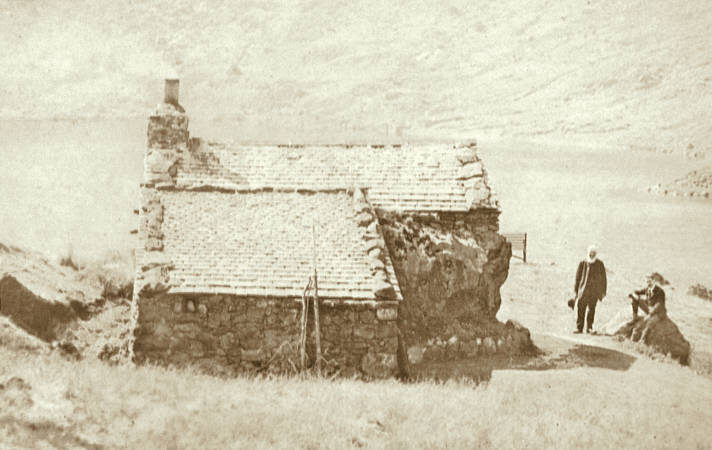
First, a description of the scene shortly before the hut was built:
"The Lake Country" by E. Lynn Linton, London, Smith, Elder & Co. (1864), page 174:
"Very wild and very lonely are these two tarns; Codale the wilder of the two, because more rock-bound and of higher altitude than Easedale, but neither sparing much for softness or tenderness, neither borrowing of the Sybarite roses or eiderdown for the rugged Doric bonework beneath; true mountain tarns, both of them, born in the wilds where but little of pleasure and less of gain leads human footsteps- their only companions the free creatures of the air and the gracious throngings of the sky. Ah! if all men could be taught the deliciousness of a lonely mountain tarn, and a rough mountain scramble, where they would cut their feet, and graze their knees, and tear their hands, and get wet-footed in the bogs, and wet-backed in the mists, and meet with nothing more exciting than a flock of frightened mountain sheep or a noisy swoop of plovers screaming overhead! If they could but be all inoculated with the love of such joys as these, how much better it would be for the present world and for future generations!"
In Cumbria magazine for September 1961 appeared a letter from Mrs Elizabeth Bassett of Cramlington, who had heard the story of the hut from the granddaughter (born in 1875 and then still living) of its builder, Robert Hayton. The story she presented does not fit easily with contemporary sources such as censuses and directories, but here is my attempt to make sense of it all:
The family legend claims the refreshment hut was a replacement for a much earlier structure, a shepherd's shelter made of turf. Robert Hayton, born in Kentmere in 1822, may have lived as a young man in the Penrith area, but on 26 March 1843 he was married at Patterdale, to Rachael Leach, who bore him a daughter, Ann, about ten weeks later. That may have been the last thing Rachael ever did, and by the 1851 census we find Robert with a new wife, Sarah, more than 20 years his senior, hill farming at Score Cragg, Grasmere (rented from Lord Lonsdale's estates, according to Mrs Bassett). He remained there until the 1860s, but in the 1871 census we find him working as a postman, and living at Stubdale Cottage, on Easedale Road. As the next quotation suggests, it must have been about this time that Robert created the well-remembered hut. According to the family version, his son helped with the blasting operation to create a level foundation for the hut (I have yet to find any evidence that he had a son, but he did have a son-in-law, William Wilson, son of George and Mary Wilson, just slightly younger than Ann, whom he had married at Grasmere in June 1866) and twenty men carried materials such as timber and roofing slabs up from Grasmere.
"A Guide to the English Lake District Intended principally for the Use of Pedestrians" by A Cambridge Man, 3rd edition, Windermere, J. Garnett (undated, c1870), pages 23-4:
"An excursion into EASEDALE is one of the best things to be done from Grasmere. This is a valley of great beauty, lying above Grasmere, and separated from the Keswick road by Helm Crag: there is a path for ponies all the way up the valley, and the stream which flows by the side of it in one place makes a very fair waterfall. At the high end of the valley lies Easedale Tarn (915 feet above the sea level), a piece of water of considerable size, and about 1¼ hour's walk from Grasmere: there is a boat for hire upon the tarn, and near it a hut, where a humble style of refreshment may be had."
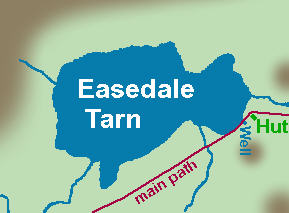 "Tourists' Guide to the English Lakes" by Henry Irwin Jenkinson, London, Edward Stanford (1880), page 38:
"Tourists' Guide to the English Lakes" by Henry Irwin Jenkinson, London, Edward Stanford (1880), page 38:
... "another short climb leads to the hollow where lies Easedale Tarn. Many persons will be annoyed on finding a small hut erected in this mountain nook, which retreat seems dedicated to solitary, pleasing reverie. Refreshments are provided by the person in charge of the hut, and a boat can be hired for a row, or a little trout fishing on the tarn. The charge for boat is 1s. per hour, and 5s. per day. From the shore of the tarn rises an amphitheatre of wild, rocky precipices, Tarn Crag lying on the right, and Blake Crag directly in front, with Sergeant Man farther back. A large number of moraine heaps are on each side of the water, and the ground near the shore is rich in detached blocks."
The 1881 census reveals that Robert Hayton, widowed again and remarried to Shropshire lass Harriet, nearly 20 years his junior, had moved next door, to Easedale Lodge, where by 1885 (according to Bulmer's Directory) he was running a lodging house.
Local resident, Canon H.D. Rawnsley, describing a winter visit to Easedale Tarn in "By Fell and Dale at the English Lakes" (Glasgow, James Maclehose & Son, 1911) cast his mind back over seasons and decades:
... "we forget all the winter aspect of the scene in happy memories of pleasant summer expeditions, and the cheery cups of tea from the hands of the hut-keeper here. Rememberable too is the blue curl of smoke from the wood fire ascending into quiet air, which used to greet us from below after a long trudge over White Stones, or from the Langdale Pikes, and as we think of its pleasant welcoming, there comes back to mind the quaint talk of the hermit of the place, who with hs own hands reared the hut to be bequeathed to future generations, and who came hither day by day, through storm and fine, to await his guests.
Age fell upon him. He could no longer take the upward climb, but still he would be seen on the back of his noble 'cuddy,' and here he would spend not only long days but long nights, till the cuddy again returned to take him to his week-end home. If to any human being it has been given to find rest and quietude in his later years, 'far from the madding crowd,' it was given to old Hayton, the host of the Easedale Hut."
Mrs Bassett's family narrative seems to confirm the impression given by Rawnsley. She states that as evening approached, Hayton would "send great shouts echoing round the hills", both to guide straying ramblers and to announce that "anyone who cared to share his evening meal was welcome. Peat was burned in the old grate and simple meals cooked. There was always a store of food in the hut."
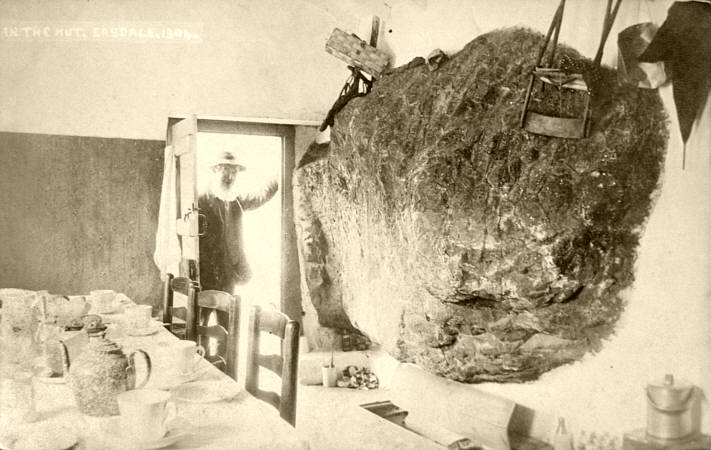
Local painter W. Heaton Cooper, in "The Tarns of Lakeland" (Grasmere, Heaton Cooper Studio, 2nd ed. 1970) provided more useful information about the hut and Mr Hayton. According to him, "its original purpose was to shelter ponies and their riders who visited the tarn," and that "on his death in 1888, a vestry meeting decided to let the hut to his daughter, Ann Wilson, for the sum of five shillings a year" (the hut was on common land, so rent was payable to "the commoners of Grasmere").
In 1975, "Cumbria" magazine sought readers' memories of Lakeland refreshment huts. The December issue included a contribution from J.E. Wynfield Rhodes of Sussex, who had visited Easedale Tarn "at least once a year from 1896 to 1904" and remembered that the proprietor then was Mr Wilson, who "when I first met him was over 80 and was a Grasmere man". He "carried every article of food there on his own back in the spring, and if he did charge one shilling for a bottle of mineral water, who could begrudge him the price?"
According to Heaton Cooper, Mr Wilson was "Swanny" Wilson, one-time proprietor of the Swan Hotel, who provided "sumptuous teas at a shilling a head"- in addition he continued the boat hire, and "kept the track drained and in good repair". This identification of Mr Wilson is interesting, for the involvement of the Wilson family with the Swan had been in the first half of the 19th century, and Ann's father-in-law George, though indeed the son of proprietors Anthony and Elizabeth Wilson (born at Hawkshead in November 1804) worked throughout his life as a labourer, while her husband William was only a child when the family left the hotel.
Also, as William Wilson would only have been in his fifties by the time Mr Rhodes visited the hut, and George had died in 1863, who was the Mr Wilson "over 80"? The only candidate I have found so far is Edward Wilson, of Ash Cottage, by the Red Lion, who died in 1910, aged 88. Born in the village, he was a joiner by trade, following his father (another Edward), but he entered the history books (specifically "The Church of Grasmere: A History" by M.L. Armitt, 1912) as a long-standing parish verger, from which post he retired only in 1906: "Intelligent, calm,
quietly humourous, he was also gifted with an accurate
memory of the events of his youth". Censuses show that his parents lived in 1851 at Stubdale Cottage on Easedale Road, and that in 1891 and 1901 his son, yet another Edward, worked as a postman.
Mrs Bassett, again referring to Hayton's successor as his son, states that Lord Lonsdale brought a party for tea around 1900, and notes that an autograph book was kept at the hut, which came to include "some of the most famous names in Europe".
"The English Lakes" by William T. Palmer, London, Adam & Charles Black (1905), page 217:
"Easedale Tarn is among the larger in size, its trout are more easily caught at hours and seasons when the tourist is unknown. At evening get out the boat and float towards the outlet. The weeds here are the nightly haunt of the best fish."
MacKenzie MacBride, in "Wild Lakeland" (London, A. & C. Black, 2nd. ed. 1928) confirmed the impression given by Palmer, that the hut closed for business in the autumn.
Returning to W. Heaton Cooper's informative work, we learn that Mr Wilson had a notable successor in the 1930s; "an Irishman, Michael O'Brien sold mineral waters there and entertained all comers with his favourite hobby, bending six inch nails with his hands into fantastic shapes". He may well have been the last proprietor of the hut, and certainly the Second World War made it impossible to revive business.
In "Around Ambleside and Grasmere" (Footpath Guides No. 51, London, St. Catherine Press, 1948) F.R. Banks noted that "The hut is fast falling into decay", and a few years later the mighty Wainwright (in the Blea Rigg chapter of his Pictorial Guide "The Central Fells", 1958) sketched the hut and described the situation in his characteristic dry style: "With every passing year the hut loses a few more stones and slates (and gains more autographs) but it still provides a draughty shelter."
Also published in 1958, in the July issue of "Cumbria" was a photo from behind the hut, showing that at some point the entirety of the rear extension shown on the top photo here had been removed.
"Cumbria: A Guide to the Lake District and its County" by John Parker [John Wyatt], Edinburgh, John Bartholomew & Son (1977), page 94:
"On the approach to the tarn there was once a refreshment hut. But by the 1960s vandals had wrecked the building. National Park Voluntary Wardens dismantled the hut and converted it into a cairn and windbreak."
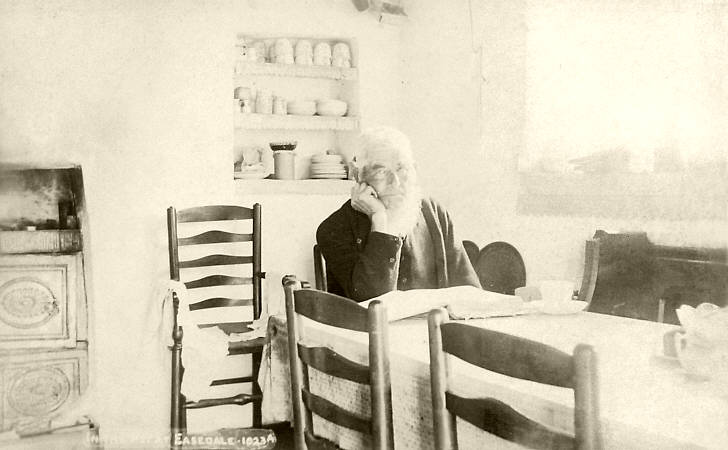
In summer 2014, I acquired two additional postcards of Easedale Tarn, from which I have enlarged the relevant sections:
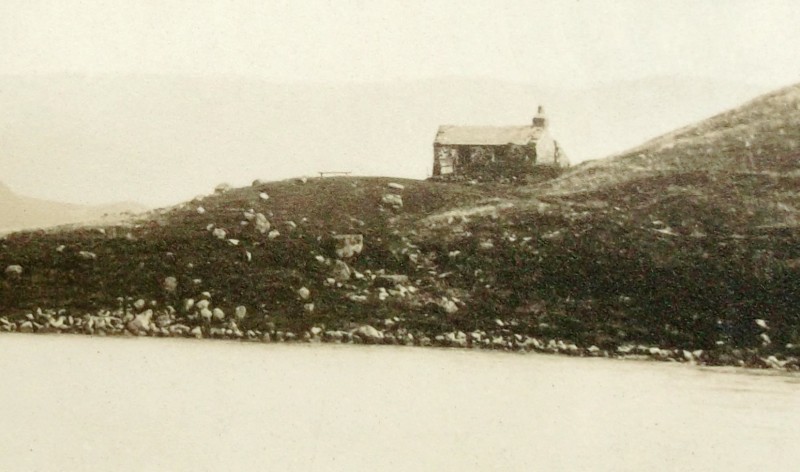
This view in the Valentine's XL Series is a late printing from an image originally made by J. Valentine & Co. of Dundee in 1894 (ref. JV-21519, now archived at the University of St. Andrews).
And the scene below is from an Edwardian tinted card by Abraham's of Keswick (ref. 323, not to be confused with no. 323 in their Real Photograph series).
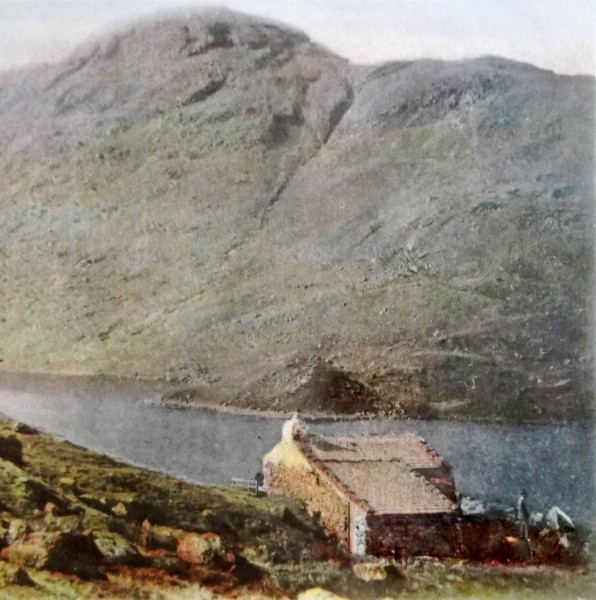
... and in summer 2018, I was informed of the existence of a new web page about William Wilson and his family, compiled by Rosa Morriss in connection with her wider family history research:
sites.google.com/view/williamhoggarth/wilson
This page includes several newspaper reports, and some good images of William and the hut. Here, courtesy of the family, is a detail from one of them: can anybody identify that decorated tin on the shelf?
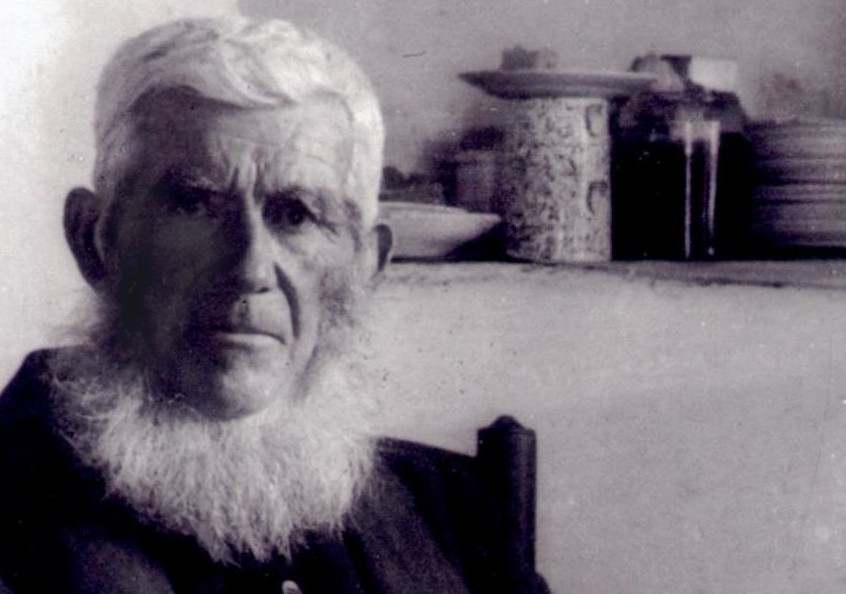



 "Tourists' Guide to the English Lakes" by Henry Irwin Jenkinson, London, Edward Stanford (1880), page 38:
"Tourists' Guide to the English Lakes" by Henry Irwin Jenkinson, London, Edward Stanford (1880), page 38:



